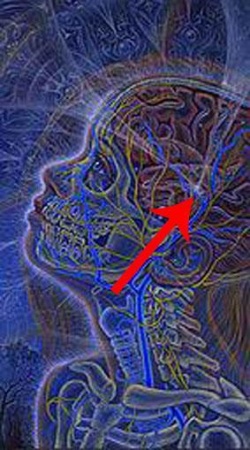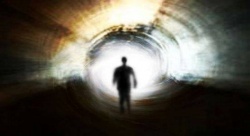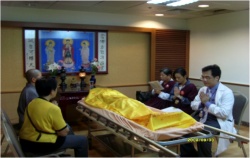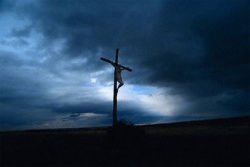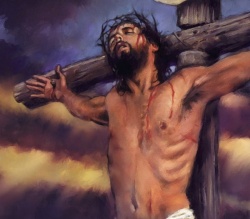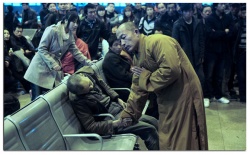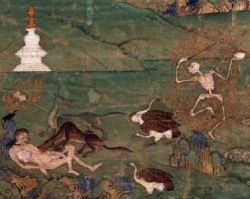On Death
Today is the last day of the seven weeks of the Bardo state of Charles' grandmother. Since I heard of her parinirvana I started to pray for her. I know she is a good lady and maybe immediately had a good rebirth in heaven, but as I am a Buddhist and since we made friendship through a Buddhist relative, I prayed for her from the first day until the forty nine days were over. Every day I prayed for her and said Amitabha's name and prayed for her rebirth in Sukhavati. Today is the last day and we invite her as a representative of Amitabha's Incarnation. The first part of the Phowa puja I have already finished. Now I come to the second part, which is to repeat the poems which I wrote in Calcutta in my graveyard hermitage. There I also prayed for the dead but in Chinese. So here I have translated the poems into English. The first one was written upon entering the graveyard hermitage:
Why need wait over one hundred years?
Just now I would like sleep in graveyard here.
Though it is right, the light of Ch'an so clear,
My heart ashes could not burn up with tears.
This entry was made in the graveyard where I lived for about two months. This is the first poem when I entered into my hermitage in that graveyard in Calcutta.
The second poem was about forbidding myself to talk to others. In the hermitage I just repeated Amitabha's name and prayed for the dead and gave some Phowa Puja. In this graveyard the family and the friends of the dead people came to worship and many Chinese people came. I did not talk with them. This poem is just about why I did not talk with them:
All men's worldly things are just the same,
Not many have perfect riches or fame.
Keep silence, I do not talk with anyone,
Bad things of them may be told by man!
The third poem was written to give thanks to the protector. It is very warm in Calcutta and at that time it was spring but the weather was like our summer. On the first day there was a little rain which washed that place and then some wind came to sweep it. So I gave thanks to the protector Dragon King. This is the third poem:
Spring sunshine is so bright, my Lord!
In the blue sky there is no cloud!
Suddenly wind sweeps and rain washes;
Dragon King protects me, a lot!
The fourth poem is under the general title of "Lamentations" and includes six poems. The first:
Between two rows of tombs there's no space to hide,
For their sons to burn incense with their guide.
Once a year there's holyday for the dead;
After this day flowers fall at tomb side.
The second:
Either ugly or pretty face,
Either so strong or so feeble race,
After death everyman's corpse
Could occupy the same little space!
The third, referring to the fact that this was a Chinese graveyard:
From our country to India, it is not near.
If just want to bury, why need to choose here?!
Are there not the same blue mountains and green grass?
India may be closer to Pure Land, my dear!
The fourth:
Like a glimpse, it is quite easy to pass.
Time directly comes to graveyard with moss.
No matter how often you are lucky,
At last, here you have to come across!
The fifth:
Could I convert stone, nodding its head so high!
Or cut my flesh to patch up your skull so nigh!
I would like to help you wake up and teach,
Let all worldlings know your death before they die!
The sixth:
I step alone in graveyard at evening;
I doubt when I shall reward the Dharma King.
The living beings I still cannot convert;
How can I talk with the souls of dead and win?
These above are the six general lamentations. The lamentations for the particular kinds of persons follow. The first one is for the scholar or poet:
Surely his mind and poetry was so nice!
He might be laureate of his age so wise!
After death only a few words of his name
Engraved on a stone tablet once but not twice!
The second is for the beautiful famous stars who were buried in the graveyard:
She was beloved by men, so pretty;
Her face like flower, body like plant.
After bury in the same graveyard,
How can we smell again her sweet scent?!
The third is for the tourists:
With car, boat and wine he toured in many countries.
Love of strangers seemed than his wife much prettier,
His boy didn't know after death he had repented.
In front of his tomb the boy raised some nice plant!
I had a boy with me who was my servant. In the East such helpers are easy to get and my sponsor always sent his servant to help me. I had some advise for this boy:
Weathered and yellow leaves fall down a plenty;
The sunset is sending crows back to their nest.
I advise my boy to have great sympathy.
Towards the tombs, please don't throw the offering plant.
During the day I practiced in that graveyard, but at midnight which is a very important time to ghosts I also practiced. Those experiences are included in these three poems:
The ghosts energy seems to pass through palm tree
As lights of phosphorus and firefly would be!
A puff of cool wind brushes away before me;
Did you really arrive pure land and be free?!!
The cool moon shines light upon the graves;
Who knows how deep were all the ghost's grief!
I ring my vajra bell so loudly.
Dogs bark one by one for some ghost's leave!!
Crescent reflection in cool pool as little eyebrow,
In middle night for the ghost I pray and bow.
Wind sends all phosphorus back towards the West.
With stars and with firefly all are in a row!
The next poem is called "Presenting Incantation to the Ghosts":
When the holy day of Ghosts' past who comes here?
Don't hold your bones here for many a year!
I present you some Buddhist incantations,
Take your seat of lotus there and end your fear!
"Sorry for the Living Chinese":
Many spaces for ghosts have been already;
Souls of living beings here will bury.
May I ask you, "Do you need rest now?"
Why those people in Chinatown so hurry?
"Go out of the Graveyard Hermitage":
Like clouds in sky I make my home one in all,
In this graveyard I have shared your wind and cool.
Now I take leave from you, before spring season ends.
I cannot bear to see flowers completely fall!
In this third part I will talk on the subject of Death in the Buddhist sense. We human beings with human nature always take care of living but never take care of dying. In fact every sentient being, either animal or mankind, who has life at the same time has death; it is not just at the time a man stops living that he meets death. One minute of living is at the same time one minute of dying. Living and dying occurs second by second, not life by life. When we are in our mother's womb and get the first breath from mother and have life, at the same time that this breath passes we begin dying. Living and dying occur together but people always put their energies in the direction of living, how to live well, how to breathe, how to be strong, how to reach old age; the dying condition they let nature itself bring to pass. This is the main problem for every sentient being. Most sentient beings take too much care of living and let the dying things naturally come to pass and don't take care of them. We are born in a family and fortunately have a mother to take care of our daily needs, give us milk, take care of our clothes. Everything is prepared for living because everybody just thinks of life, how to have a long life and be comfortable, how to livein the present, conveniently; everybody takes care of food when they are young and sex when they are grown; how to get good living accommodations, how to pass the time well, how to make oneself very happy. They never think about dying but just think "For eight years I have been a primary school student and now I am going on twelve years old; soon I will be married and become a citizen and do something for the nation." But at twelve years of age the student doesn't think that he has passed twelve years and that twelve years have died, he never has such a conception. He always looks ahead, I will be sixteen, I will get married, I will become a parent, and then I will be sixty-five and get social security. He just thinks ahead toward the living but never thinks that behind him there is death. He never thinks that he won't be as healthy at fifty as he was at twenty. This is very dangerous.
I have already said we are living and dying at the same time, so living a day is dying a day. Death and life go together arm in arm in every respiration: inhalation is life, exhalation is death. Just like the saying of Montaigne "From the day of your birth, you begin to die as well as to live." Joseph Hall also said: "Death borders upon our birth, and our cradle stands in the grave." We say that a person has died at sixty or eighty, but whatever age, he did not really die at that moment, but was continually dying from the moment of birth. There is not a single moment when death does not occur; dying and living occur at the same time, second by second. Our parents took care of our living, but they did not like to think of dying so they did not prepare us about how to die but just how to live. So when death really comes for our bodies, we are not prepared and this is very dangerous. Just about every person, no matter how wise, how deep is his knowledge, does not take care of this. But according to every religion it is said that if you take care of the next world while living in this one, you will have the best of both this world and the next; but if you sell the next world for the pleasures of this world, you will forfeit both this world and the next. The Buddhists especially developed a very good religion to prepare one for Death and Rebirth and have many doctrines to make you aware of Death.
Christianity says you must just have faith in God. If you have faith at the moment of your death, you will ascend. If not, you will fall; so here in this world there is no need to have any preparation for Death except faith in God, every day pray to God. But Buddhists are very aware of Death, very aware of the knowledge of Impermanence. Christ saved us through his Death. He preached a few years and did not preach many doctrines, only a few pages, but he used the crucifixion to redeem everybody's sin. When you have faith in him, as he died for you, so will you follow him into heaven as he said. If you follow selfishness, you will fall into Hell. This is a symbol of God's sacrifice to make us want to be reborn in Heaven. It is with his death and not with his life that Christ really taught. He lived not very long, and gave few speeches, but the crucifixion is the important thing. That is why the Catholics have a practice in which they meditate on the fourteen stages of the Cross. Other religions, as Islam, emphasize only living; they like to take beef, can marry four wives, and they preach: if you have belief I will be your friend, if you do not believe, I will fight with you. This is why Islam always fights with Christianity, even though both religions have told the same story.
The fourteen meditations on the crucifixion are a very good doctrine of Catholicism which uses the death of Jesus. I do appreciate it and have made fourteen poems, one on each of the stations of going to the crucifixion. I quote them below:
On Crucifixion
1. "Condemned to Death"
Crowned of thorns to Jesus misdeemed.
Should the God's Son have his own sin?
It was God sending his son for us,
As we have sinned, through him to redeem.
2. "Bearing the Cross"
On the cross there's all mankind's heavy sin.
Who could bear, except you, the great compassion?
We should have thanked you not only with tears;
We must be pure without sin and delusion.
3. "The First Fall"
Blood and flesh were served the supper last night;
Your prayer moved not the cup even so right.
The attainment of your mercy was so deep,
Make you fall down even you're almighty.
4. "Met his Mother"
When you rose up from the dusty ground,
Just then was your mother to be found.
Taught us to confess our sins early,
To be loved and free from burdens wrung.
5. "Simon Shared the Load"
It was the good Simon who shared your load!
I am sad then I was not with Lord!
Now the great event falls on my shoulders;
I wish I may get your help a lot.
6. "Veronica Wipes the Face of Jesus"
Tears of pity were shed when you bore the cross.
Lament still remains though thousand years have passed.
I envy that Veronica had wiped it,
Though, like blood, my red candles on Homa across.
7. "The Second Fall"
Sins full of the sky you had born all.
So far away you went in the cool.
For others' sake you staggered and fell;
Taught us to rise even after fall.
8. "Met Women Weeping"
The image makes us sad even now.
The women who met you, how could they bear?
One who has sin could not console you.
Should we never sin again we must know!
9. "The Third Fall"
Your great power could raise the dead!
You might bear the heavy load you had!
Still you fell and rose up three times;
Taught us to confess even so bad!
10. "Garment Stripped"
Neither had you Church nor food,
But gave teachings in deep mood!
What a cruelty it was!
Keep no garment you could!
11. "Nailed on the Cross"
Who was so cruel you to nail?
"Lord of the World" all did hail!
Who could nail all sages of five signs?
Each age has one following so well!
12. "Salvation through His Death"
You loved all and were victim for all!
Our merciful God to you so cool!
To redeem our sins was so difficult,
That God put you to death to save us whole!
"Laid in Mother's Arms"
13.1
It was given back to her
Who was chos'n to give him life.
To whom it was still as dear
As though he were still alive.
13.2
Under the cross Mother met your death.
How could she bear to think of your holy birth?!
From her deepest lament tears were falling down.
Drop by drop till it mingles with ours.
14. "Jesus Ascended to Heaven"
Where on the Earth could be the holy mountain?
Which could bury you forever to maintain?
Even the stone gate could not keep you at all;
Flown to the holy heaven you did attain.
Most religions emphasize living but the doctrines of Buddhism talk about Death. All the three yanas, Hinayana, Mahayana, and Vajrayana, are very seriously connected with a doctrine concerning Death. I will talk about these three yanas and how they use Death.
Hinayana uses Death to reduce desire. This is an important point in Hinayana. Mahayana uses Death to do some good for others. Vajrayana has many methods to take advantage of Death and achieve Buddhahood. One by one I will talk about these.
Hinayana takes Death as a Meditation, called the Nine Stages of Death. The first stage is to think of a dead body as swelling up. The person should think "When I die, my body will also swell up, just like any other body." The second stage is thinking of the skin of a dead body becoming blue and mottled. This kind of practice is important. Human beings have eyes but they only use them to see ahead; they never use them to look at their own bodies. Their eyes are under the forehead but never see behind or inside the head. Their view is just external, they do not see their own internal body. The same with the nose, with smelling and breathing. People inhale and exhale but never keep anything inside; whatever comes in goes out. All our bodies contain thirty-six impure things according to Buddhist doctrine. This Hinayana practice on Death concentrates on seeing our own bodies as impermanent.
After the first two stages of swollen body and blue mottled color, the practitioner must think of his body in a state of decay. This is the third stage. The fourth stage is when the stool and urine comes to the outside of the body and then in the fifth stage the flesh becomes rotten and smells bad. In the sixth stage the birds and beasts come to eat the flesh, in a wild place or in a graveyard. The seventh stage is when the body becomes dismembered as animals come and tear it apart. In the eighth stage, only the bones remain as the flesh has already been taken by the beasts. The final ninth stage is when somebody puts the body into a fire and it is reduced to ashes. As is said, everybody and everything returns to dust. Hinayana practitioners practice these nine stages altogethher.
That is why the Hinayanist, without wife, without any communication, just living in the mountains, very quietly, knowing that he will die, fearing death and thinking about death, recognizing that everything in this world brings disappointment, that worldly things have no value, has as his only work to think of death and take advantage of this present moment to take refuge and repeat Buddha's name. Whenever you think of the next world as being valuable, you can do something for yourself. You can become diligent and when you think of death choose the valuable thing to do, to leave all things of nonsense and stop pursuing desires. Do not pursue sex or food or money, all is nonsense. When you die, your money does you no good and nothing remains. This is the practice of Hinayana; it is a kind of negative view. The main practice of Hinayana is to fear death and reduce desire; desire just shortens life and increases disease. When worldly desires are reduced, whatever such a person does, he does the Dharma. He repeats incantations, worships Buddha, and prays that when death comes he will be helped to go to the next world of the Pure Land.
There are many such practices, not only thinking of the body as dead, but also recognizing that there is not a place you can escape from death. You may think, "Oh the sky, if I fly I can escape death"--but you cannot. If I live in a cave, can I escape? In the caves people also die. Under water, one also may die. There is no place to escape death. And there is no one who can die in your place. Your father or mother may think, "Oh, I am old, I would like to die in your place." They may have such a good and kind idea, they may pray for it, but they can never do it. No one can die in your place. Your father, mother, doctor, teachers, and government all teach and protect you to live, but no one can protect you from dying. Many medical centers help you to live, but there is no medicine which can help you to go to Heaven or become a Buddha.
Another practice is to think that there is no certain time of Death. Some people die in their mother's womb, some die as babies, some as boys, some in early manhood and some in old age; but even if you live 100 or 200 years, sometime you will die and you do not know when that will be. Death has no certain predetermined moment. In modern times, with more mechanized developments, there are more conditions under which to die. In olden times people died in wars or on boats; but nowadays people die in airplanes and automobiles. There also are so many kinds of drugs nowadays and every drug can create a dangerous condition. Most people used to fear death, but now many people do not fear it. What is the use to live, they say, to die and be dead we only have to do once. They think nothing happens after death; they do not realize that they will be born again and die again. They do not know these things, so there are many people who dare to die.
Some people purposefully plant a bomb when they know it will go off. In ancient times we never heard of such a thing; that is so easy to die. Today there are so many civil and international wars, so many people sell their lives to their party or country.
One should prepare for death and think, "Suppose I die, where shall I go? it is according to my Karma. So how to change my karma, what karma can I do to go to heaven, what karma will lead me to hell or to an animal state, and what must I do to become a human being again? The right-minded person will take care of all these things, will take care of his conduct, of his mind and of his living conditions. Then he will choose the good and leave the bad. What I have been talking about is the Hinayana practices.
Now we talk about Mahayana. The Mahayanists also use death for their own practice. In Mahayana the main purpose is not only to save oneself but also to save others. So the Mahayanists practice the Six Paramitas. The first one is called Almsgiving. He may give his eyes for us, he may give his head for us, he may give all his blood. The Buddhists of Mahayana are willing to die for others. Many Bodhisattvas died in this way. Surely such a person will be reborn again to help others. There is a Sutra called the Great Compassion Flowers which records how many Bodhisattvas have died in this way, only for others.
The Second Paramita is to keep the Vinaya. This means not to fight with others. Suppose somebody wants to kill you, you must let them kill you or you will not get a good rebirth. So to keep the commandments, to keep the vinaya, it may also be necessary to die. Once there was a sage Nagarjuna who was really accomplished in non-death yoga and nobody could kill him. But he was able to be killed as a return of his bad karma because once he had killed some grass. One day a robber came to rob him and wanted to kill him. The knife was on his neck, but Nagarjuna told the robber, "You cannot kill me in such a way. I have not killed a human being but I have harmed the grass, so you must put some grass around my neck and then I will be finished off. If you try to kill me otherwise you will not succeed, as I have accomplished this supernatural power." So the robber took the grass and did as bid, and Nagarjuna died. This was from pursuing bad karma towards a plant. If you harm a plant, you will also reap a result. In order to keep the good Vinaya, you may have to die. The Bodhisattva may also die but from this kind of death, you can get good rebirth again. So for him, life is very easy to get as he has no bad karma to fall into hell or as a ghost.
The Third Paramita is Patience. Do not fight back even if you are treated badly, but you must bear it with patience. If you are fought unto death, you must also accept it with patience.
The Fourth Paramita is Diligence. Keep diligence. This is very difficult for modern youths. Hinayanists are so diligent that they do not go to sleep. Even with little food, they practice. They always meditate, so they may die in diligence.
The Fifth Paramita is Dhyana or Meditation, or Samatha. They stay in concentration until death. Once a Bodhisattva meditated in a tree for 1000 years and did not die. When the Governor heard of this, he had the tree brought to him and the branches were cut away. The monk was still there breathing. Slowly he rang a bell and the monk slowly opened his eyes and looked around. When he was awake he asked, how long have I been here? And then asked about whether his friend was still alive. This was a very learned person about 1000 years before. So such a Bodhisattva, when he heard of his friend's death, he also immediately died. Such is a death in meditation.
The Sixth Paramita is Wisdom. Many people have died in the search for Wisdom. Once there was a monk who came to India with forty companions, but most of these people died on the way over the Himalayas so that only a few remained. They just pursued Buddha's wisdom.
Once an Indian person came to China to promote the Dharma, but at that time it was very difficult to bring the teachings out of India. So he just opened his skin and put very small paper inside so that he brought the Dharma even with his body. By these ways Death has been utilized for Goodness, for the Great Bodhicitta, for the great vow, for the great purpose to save others. Such a death is very valuable.
Bodhisattvas as Avalokitesvara have thirty-two kinds of bodily transformations; they can be a king, god, arhat, dragon-king, woman, teacher, doctor, and all good beings; he can also become an animal as deer, elephant, etc. Whenever he transforms his body into that kind, he helps that kind. So there are many Bodhisattvas also who use death to further a good purpose.
As for Tantra: Vajrayana Buddhism teaches not only negatively how to make one's self a victim, but also positively how to do something to help others. Many good Tantric methods take advantage of Death visualizations to achieve Buddhahood. Tantric Death is able to achieve Buddhahood; if you wish to know how to die in this way, this part will speak about this.
First, there is the method to make Death into a spiritual food to increase the possibility of becoming a Buddha. How to do this? The practitioner must visualize his body as a corpse and visualize cutting this corpse up part by part; he cooks his heart, cooks his belly, and cooks his legs as an offering of food to the Heruka Gods and to the Buddhas. Some of this food is given to the Ghosts, some to animals, some to Gods or to Protectors. By practicing like this every day, the visualization becomes strong but his body actually does not die. He sees himself as a corpse and cuts himself up, offers himself completely, and returns any debts he may have from his karmas that might be obstacles to becoming a Buddha. As he has created many debts, life after life, he must repay them. So he cuts off his head and offers it to his debtors as his redemption. So on one hand he returns his debt and on the other hand increases his merits by making offerings to the Buddhas and Herukas and asks them to take his nectar and give him their wisdom. "Give me your blessing, give me your great compassion and bless me to become a Buddha." This is a kind of method called Chod. Everyday the practitioner comes to the cemetery and repeats many good stanzas, like poems, and makes offerings to the Ghosts and receives some Buddhist teachings. This kind of visualization really affects something and is not just abstract ideas but concrete forms. This practice of Chod uses a big drum and human bones. The practitioner travels everywhere and does not live in a monastery or house. This is a way to use Death.
Another way is through Phowa practice. Actually, living is by the mind and dying is also by one's consciousness. If you have only a body, you have no consciousness and you may take food but you don't experience the taste. When you have consciousness then you can taste the food, what is the good taste or bad taste. If you are only an open mouth and your mind is thinking of your love who has gone away and has not written to you, then your consciousness will be concentrated on that love and you will not taste your food. You must renounce such attachment and get back your consciousness in order to taste the food. Then you will think, "Oh this food has a very good taste." Living must use the consciousness and dying also must use the consciousness. Consciousness is the thing that enters the womb of our mother first and leaves our body last. Everything of the body may be dead and the flesh rotten, but the consciousness even though it cannot think or hear, is still there. While there is a little breath or a little warmth, consciousness is still there, and as the last warmth leaves, the consciousness also departs.
The practice of Tantra can push this kind of consciousness into the Buddha's heart instead of going into another mother's womb. The Tantra has many good methods to push up one's consciousness further into Buddha's mind or heart and identify both into one. In the cemetery ritual I perform, when I say "HEE", this is to push the dead person's mind who has been visualized as the Nirmanakaya of Amitabha up into the Sambhogakaya of Amitabha and he then becomes Buddha. When I say "PEI", this is to push the mind of Sambhogakaya further up into the Dharmakaya of Amitabha which is the permanent and bright light of Sunyata, and which by other names may be called full Enlightenment or Nirvana.
There is another way to become Buddha and take advantage of Death. Suppose your Phowa did not succeed, so your consciousness enters the Bardo state as has been written about in The Tibetan Book of the Dead. When a person comes to this Bardo stage he can see both the Buddha light and the Demon light. If he has learned about this method in the Bardo Stage and has read this book, he may know now how to choose--one light is a little brighter than the other one, you must leave the dark and choose the light. If you prepared how to die when you were alive, you will know how to repeat, "OM MANI PADME HUM", "OM AMITABHA SHEY", "OM NAMO AMITABHAYA" and all other incantations. At the time of death you will still remember them if you practiced reciting them during your lifetime for our habits stay with us even after death. If your life was aimed at food, sex, and stimulating things, then that is what you will think of after death. If you have prepared for death and have repeated incantations, when you die you will remember them and repeat them at that time and the Buddha in the Bardo state may save you. You will be able to recognize which path leads to Hell, which to animals, which to Ghosts.
The Tantra has written about how which gate the consciousness leaves will determine in what state you will be reborn. For example, if your consciousness leaves from the feet, it will go to Hell. So there have been practices devised to cover all the gates of the body except the one at the top of the head so that the consciousness may leave from there and achieve the highest state. But this demands much preparation. The common person does not know of such things.
This method utilizes the time of death and the Bardo state. If a person is prepared, if he has studied and received initiations and has practiced, then at the time of death he can use this knowledge to help himself. The common person does not know of this but is just covered with ignorance and doesn't know when they meet a certain sound what they should do; they just wander everywhere without choice. He just goes wherever his old habits guiding him and nobody can correct this tendency. This habit is from living, so if we change our habits in living and prepare for death, we'll have good habits in how to die and how to choose the body of our next world.
There is also a method of how to die in the Dharmakaya. Dharmakaya is non-self and non-form and non-haveness and non-desire. If you know this method, you practice Mahamudra and the Sunyata. First of all, the whole universe, everything in the universe, becomes void. This means that a mountain is not a mountain, a river not a river, a home not a home, wall not a wall, body not a body. Everything in the universe becomes light and this light enters into the heart and from the heart into the lotus and from the lotus into the Bija, the seed, and this seed which is a mantric syllable, such as HUM, dissolves upward from the bottom part first until the fifth and final part dissolves into a small hair, and from that hair dissolves altogether into Voidness. This is the Dharmakaya. Because you have done this practice many times in your lifetime, when death comes this practice will continue. The practitioner knows this is part of the Dharmakaya and very carefully keeps his Samadhi. But the common person never practices such things, and doesn't know how to utilize this moment, so he loses the chance to enter the Dharmakaya. But if you have taken this Tantric doctrine and have had initiation, have practiced it diligently and have practiced every day this "dissolving" practice, then everything will dissolve inwardly to the body, the body to the heart, and the heart will dissolve with the consciousness. If you follow this practice, in your lifetime you can see the Dharmakaya light and in death you can really be in the Dharmakaya. In this way you can use Death to become Buddha. This is very difficult to practice but it is a real possibility that is open to you.
When you become Dharmakaya, from there you can come to the Sambhogakaya and from Sambhogakaya to the Nirmanakaya. This practice does not mean that you stop at the Dharmakaya. When you enter Death you have to be in the Dharmakaya, that is its nature. Just like there is water and the sun shines on the water and makes steam, which rises upward to form a cloud, and then the clouds gather and it rains again, forming water. Just like this: the sunshine is the Dharmakaya, the steam rising is the Sambhogakaya, and the rain which forms is the Nirmanakaya; always in this circularity.
One highest doctrine is contradictory to Death. Non-Death Yoga is this doctrine which I have talked about in my Booklet New No. 86. If you follow this practice it is also possible to get Non-Death. Many have achieved non-death in Tibet, China, and India. The basic philosophy of this doctrine is that there is no time limitation as the past actually has no past, for where has it gone ? The future did not come as it is tomorrow, but tomorrow does not really come from any place. Today is the yesterday of tomorrow and today is the tomorrow of yesterday, too. These three periods of time all together are one; and if this is so, where is death and where is birth? There is no certain point in which you are born, or in which you die, or even in which you exist. So altogether the Dharmakaya is in these three times and the ten directions of the Dharmakaya have no limitation of time or space; this is the Dharmakaya. This is what is called Truth. Truth is and was and shall be. There is no boundary called birth or one called death. It is possible through the practice of this abstract philosophy, through meditation, to get the concrete embodiment of this doctrine, the Non-Death of the Dharmakaya. This is the Non-Death Yoga.
I hope you may get the full Enlightenment of the Non-Death Yoga. Thank you.

